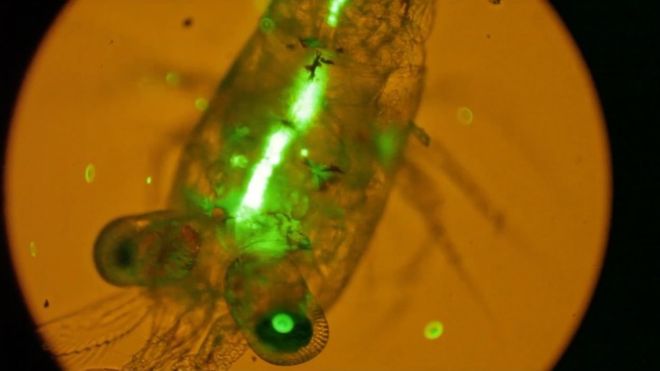Images of seals, turtles and seabirds trapped in plastic rings, ropes and sheeting always have the power to shock.
And on a visit to Midway Atoll in the Pacific Ocean, I saw for myself how the island`s magnificent albatrosses were eating plastic waste that often proved fatal to them.
The tropical beaches were littered with the bodies of albatross chicks whose bellies were filled with everything from old toothbrushes to cigarette lighters to fragments of plastic toys.
One particularly moving sight was a baby albatross chick with a small plastic hook jammed in its beak - its parents would have mistaken the object for food.
And when a wildlife ranger pulled the hook out, we saw that it was attached to a little net of the kind that holds nuts or sweets in a supermarket.
Bird blight
It was a graphic example of the potentially deadly effect of our disposable culture - and rammed home the point to me that when it comes to throwing away rubbish, "away" is not some abstract space but a real location.
So how bad is the problem? The grim assessment on Midway was that every single bird was likely to have ingested some quantity of plastic.
And that chimes with much more recent worldwide research that estimates that 90% of all seabirds have swallowed plastic - and that by 2050, it`s virtually certain that any bird found dead will have plastic in its stomach.
So to make that projection feasible, how much of the stuff is drifting in the oceans?
Getting an exact number is never going to be possible but my colleague Jon Amos reported on research earlier this year that came up with an estimate: that about eight million tonnes of plastic waste are added to the oceans every year.
That obviously comes with caveats - and a range of possibilities - but highlights how the scale of the problem is growing.
That`s because the plastic, cleverly and usefully designed to be flexible and durable, lingers in the waters.
Plastic trawl
First to break down are the plastic bags - the stresses of wind, waves and tides start to tear them apart and eventually break them into a blizzard of millions of tiny pieces.
At this point the waste switches from being a highly visible problem to one that`s almost invisible to the naked eye but potentially far more damaging - and these so-called micro-plastics have become the focus of a whole new field of research.
I joined a team from Plymouth Marine Laboratory on board the research vessel, the Quest, as a series of collecting operations was carried out.
At six different sites - each being sampled once a month - an array of three large nets was lowered just below the surface and dragged through the water for 10 minutes at a time.
Fishing for plastic: The team at work
At the base of each net was a small container and, when the equipment was retrieved on to the stern of the vessel, the contents were filtered and then analysed.
The most striking finding so far is that every single sampling operation in the course of the project has found pieces of plastic - usually very small, some white, some blue, but mingling unmistakeably with clouds of that vital life-form, plankton.
Back in the laboratory, the scientists reckon that roughly one-third of these plastic fragments have come from the remains of bags or wrapping.
Tiny meal
Some of the stuff has been blown off landfill sites that are close to the shore. Much of the rest might have come from sewers.
So does this matter? At this stage, no-one can tell.
Tests have shown very clearly that when miniscule particles of plastic are in the water, then the creatures at the bottom of the food chain do ingest them.
Remarkable video footage shows fluorescent pieces of plastic drifting near some copepods - a form of plankton - and then being sucked in by them, travelling into their guts.
And if the plastics reach that fundamental layer of the web of ocean feeding, then in theory they can be passed up into the kinds of seafood that we might eat.
So could plastic pollution harm human health?
One of those involved in the project, Prof Tamara Galloway of Exeter University, quotes research estimating that anyone consuming an average amount of seafood would ingest about 11,000 plastic particles a year.
That sounds a lot, and there`s a presumption that this can`t be good for people, but getting to grips with the precise implications will take a lot more work.
I ask Tamara and her colleagues if they are now eating less seafood. Yes, is the answer.
Changed behaviour
I can`t help noticing that their sampling bottles are made of plastic but what about their everyday lives - do they avoid the stuff?
Yes, they say - "we don`t buy plastic bottles of water and try to avoid plastic wrapping on food".
The plan to introduce a 5p charge for plastic bags in England goes down well - anything that slows the stream of plastic into the environment is welcomed.
But even if that stream could be totally shut off tomorrow - on every continent and in every ocean - the effects will still be felt for decades to come.
More about:
















































